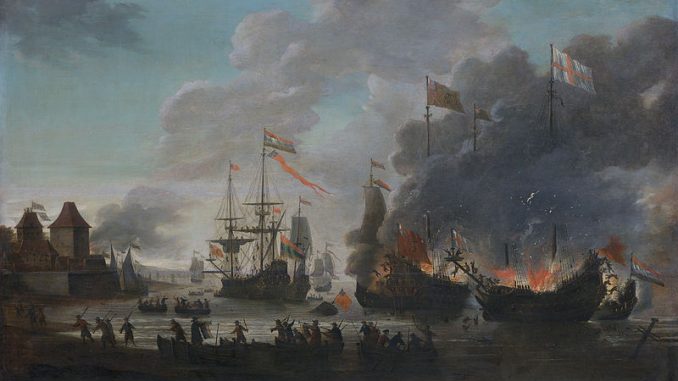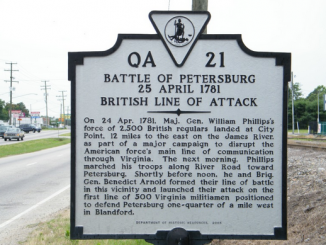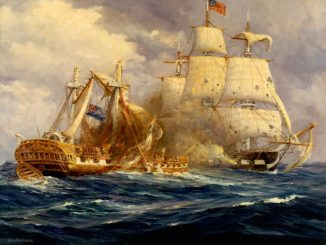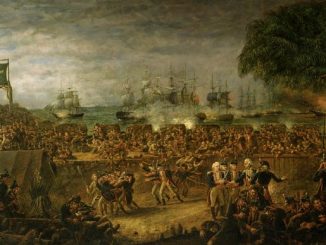
Later the same day, Jones continued from Whitehaven, where he began his sailing career, to his home territory of Kirkcudbright Bay, Scotland. There he intended to abduct the earl of Selkirk, and then exchange him for American sailors held captive by Britain. Although he did not find the earl at home, Jones’ crew was able to steal all his silver, including his wife’s teapot, still containing her breakfast tea. From Scotland, Jones sailed across the Irish Sea to Carrickfergus, where the Ranger captured the HMS Drake after delivering fatal wounds to the British ship’s captain and lieutenant.
Widget not in any sidebars
In September 1779, Jones fought one of the fiercest battles in naval history when he led the USS Bonhomme Richard frigate, named for Benjamin Franklin, in an engagement with the 50-gun British warship HMS Serapis. The USS Bonhomme Richard was struck; it began taking on water and caught fire. When the British captain of the Serapis ordered Jones to surrender, Jones famously replied, “I have not yet begun to fight!” A few hours later, the British captain and crew of the Serapis admitted defeat and Jones took command of their ship.
Jones went on to establish himself as one of the greatest naval commanders in history; he is remembered, along with John Barry, as a Father of the American Navy. He is buried in a crypt in the U.S. Naval Academy Chapel at Annapolis, Maryland, where a Marine honor guard stands at attention in his honor whenever the crypt is open to the public.





John Paul Jones burns Whitehaven, England
Not sure where you got your facts from, but the version of events shown above bears little resemblance of the true story which I have included below:
John Paul Jones
The Raid on Whitehaven in 1778
Night-time Landing at Whitehaven
Late at night on April 22nd, 1778, the USS Ranger stood about 2 miles off the unsuspecting town of Whitehaven on a clear but cold and frosty night. Two boats were let down into the water and filled with about 30 men armed with pistols and cutlasses. John Paul Jones took charge of one with his Swedish second in command, one of the few he felt he could trust, Lieutenant Meijer. The other boat was commanded by Lieutenant Wallingford of the US marines and Midshipman Ben Hill. The two boats rowed against the tide for 3 hours to reach the harbour where Jones planned to destroy hundreds of ships by setting them alight as they lay stranded in the low water and packed tight together, several abreast, against the piers.
The plan was already becoming unstuck because of delays due to the mutinous crew and poor winds. They first tried to make a landing on the coast near Saltom Pit, in order to run along the shore and attack first the guns of the lunette battery, but the sea was too rough and the shore too rocky. This attempt lost them half an hour and as they then rowed past the battery around the New Quay and into the harbour, first light was appearing over the hills behind Whitehaven on April 23rd, 1778.
Disabling the Defences
The intention was for Wallingford’s men to burn the ships in the northern half of the harbour as Jones led a raid on the fort to spike the guns. This was vital to secure escape after their mission as the guns of the fort covered the harbour entrance and could have blasted the small boats as they made their retreat. John Paul Jones landed first, near the battlements. As it was a cold night, the guards had gone into the guardhouse at the back of the fort to keep warm. According to Jones, he himself led the surprise attack. By climbing on each other’s shoulders, they managed to silently scale the walls, enter the fort, burst into the guardhouse, and secure the surprised guards without bloodshed.
He left Lieutenant Meijer guarding his boat, which was wise, as according to the Swede the rest had concocted a plan to take the boat and leave Jones behind had he not been successful. In fact, it was not until John Paul Jones himself stood on the battlements, gave his men reassurance, and encouraged them to become heroes, that they plucked up courage to join his mission.
Having secured the fort Jones took Midshipman Joe Green to spike the guns at the Half-moon Battery which lay on the shore, 250m from the fort, behind Tom Hurd’s rock. This probably contained 32-pounders that could fire over a mile and it was thus vital to the escape that these were incapacitated. He sent the rest of his men to burn the shipping in the southern part of the harbour.
Whilst their Captain was disabling the guns, Wallingford and his men landed at the Old Quay slip and headed straight to the pub and got drunk. That might be a little unfair as it is thought Nicholas Allison’s public house was on the Old Quay near the ships, so they secured the house to make sure no-one left and gave the game away. They also later told Jones that they needed to get a light for their incendiaries, but apparently, they did make very free with the liquors etc.
Attempting the Arson
When Jones returned, he was dismayed to find that no ships had yet been set on fire apparently because his own crew as well as Wallingford’s had no light, their candles having burnt out. With daylight returning they gave up on the North harbour and after securing a light from the house headed along the pier.
Soon the saboteurs got to nearest of the ships, The Thompson, which was full of coal for Dublin. They got out of bed the boys left aboard to look after it and the next ship, The Saltham, and tried to bribe them with money to go with them. The boys refused and so were taken in just their shirts, gagged with handkerchiefs, back to the Old Quay under the threat of being shot. “Matches” made from canvas covered in sulphur were set alight and thrown into the holds of several ships. On the Thompson they threw down a barrel of tar near the main mast and as the fire started to take hold, they made their retreat. The fire took hold in the steerage of the ship and eventually burnt out the cabin. The Thompson, captained by Richard Johnson, was a new ship built in Whitehaven and said to be one of the finest, which probably meant it was also one of the biggest.
Somehow, amongst all this confusion, one of Jones’s men who went by the name of David Freeman had slipped away and started knocking on the doors on Marlborough street to warn the town that the fires had been started in the ships and the whole town would be consumed. This may have occurred had the townspeople not acted quickly. It was only just over a century earlier that London had burned down after a simple fire in a baker’s shop – The Whitehaven ships set alight were full of coal and next to the coal staithes which kept a large reservoir of coal. It was low water, so the entire fleet packed closely together was stuck in the mud and unable to move away from the fire. Many of the warehouses, full of combustibles such as rum, sugar and tobacco, were built right up to the harbour’s edge to facilitate easy unloading of cargoes.
Fortunately, however, being aware of these dangers the town had fire engines. These were immediately deployed and with valiant exertions by all classes of people working together they were able to extinguish the flames before they reached the rigging. From the rigging fire could easily have spread to neighbouring vessels. The matches thrown down into the other ships including the Saltham did not take hold.
Escaping from Whitehaven
John Paul Jones claimed he stood on the pier between the Thompson and the townsfolk until the fire took hold and they retreated when he threatened them. As it was 4 o’clock in the morning one could guess most people were asleep and initially there would be a lot of confusion as to what was going on. They may not have approached Jones as he was armed, and the boys were held hostage at gunpoint. Next, the immediate response would be to deal with the fire – which they did successfully.
Jones was short of space in the boats so only took three prisoners with him. The boy from the Saltham had managed to escape but the one from the Thompson was taken. Another of the prisoners was former master of the Isaac and Barbary, George Jefferson, who had unfortunately gone down to the pier for a spot of late-night fishing. As soon as Jones and his men started rowing for the ship, people ran to the forts and started working on the guns. They managed to get two of them in working order at the half-moon battery and fired upon the retreating boats but wildly missed.
Long Tom a 32-pounder cannon recovered from the shingle beach in 1963 was probably one from the half-moon battery spiked by John Paul Jones.
The Ranger had been facing North and the crew onboard started to think the mission was a failure and began to worry that their forces had been captured. Then they spied the boats leaving harbour and some smoke from the Thompson. The firing of shots alerted them that this was Jones, and they turned Ranger around to pick up their Captain and his men. U.S.S. Ranger then fled north-westward towards the Scottish coast.
So ended the attack on Whitehaven of 1778. In truth, despite being audacious, having the advantage of surprise and Jones’s inside knowledge, the attack had been a bungled failure. This seems to have been due largely to the American crew’s reluctance to “destroy poor people’s property” as Wallingford had put it. However, the shock waves, that it sent throughout the country were completely out of proportion with the mere few hundred pounds worth of damage caused and turned John Paul Jones into an infamous pirate. Importantly, it awakened everyone to the threat of invasion. The defences of not only Whitehaven but also the entire British coast were improved, and more volunteers joined the militias. In short, John Paul Jones did Britain a favour because his actions probably prevented a full-scale French invasion.
The attack on Whitehaven was a failure. The town was not burned nor were the ships in the harbour. His own men warned the people in the town and the “matches” they used to set the ships on fire did not work. Not to mention many of his men were drunk after spending most of the night in the local pub.